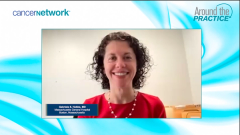
Key Takeaways: Optimal Use of JAK Inhibitors in MF and Future Directions in Care
Panelists share key takeaways on management strategies in myelofibrosis and hope for future evolutions in the treatment paradigm.
Episodes in this series

Transcript:
John O. Mascarenhas, MD: We’re coming close to the close of this program. I’ll ask [Dr Kuykendall] this question. It’s December 2023, you get a call from the nurse in the clinic, and it is the call that you’re always thinking about, you’ve got the approved momelotinib option now. So, four JAK [Janus kinase] inhibitors. You’ve got the patient in the clinic who you saw the week before and the data are all back in primary myelofibrosis, and you’ve got to make a decision about what JAK inhibitor you’re going to use in that patient. So, this is a first-line patient. Is it going to remain ruxolitinib? Are you going to use momelotinib? Are you going to tell me it depends on the label? Where do you see momelotinib fitting in in the future?
Andrew T. Kuykendall, MD: It’s December, and in Florida it’s probably the best time to be around. But I think that obviously the label’s the label, and we’ll certainly reference it. The trial was obviously done as a second-line trial, as [Dr Hobbs] said, so these patients had received first-line ruxolitinib. What we’ve seen from the data consistently through the Simplify [2 phase III trials, Simplify 1 (NCT01969838) and Simplify 2 (NCT02101268)] and the MOMENTUM [phase III trial, NCT04173494] studies is that momelotinib is an effective agent in terms of spleen volume control. It’s relatively effective in terms of symptom control, but certainly for symptoms that are associated with anemia. For this anemic patient population, it certainly could be a consideration in the frontline setting. Pacritinib may also be an option in these patients, but again, it wasn’t looked at in the same way that the momelotinib was. It hasn’t always been a part of pacritinib story until recently. I think that little bit remains to be seen. This is a patient who has a hemoglobin close to 10, who’s never needed a transfusion, and who has prominent splenomegaly and prominent constitutional symptoms. Ruxolitinib still remains to be their first-line agent. If this is a patient whose hemoglobin is 7.8 and hasn’t required a blood transfusion, they have a big spleen, some degree of symptoms, but a ton of fatigue and it seems like the anemia is more of a problem, then I think momelotinib’s a very reasonable frontline choice in that patient. Because your other alternative is to start them on ruxolitinib, go through the process of getting them approved, prior [authorizations], all those things, getting them access to ruxolitinib, and then very quickly having to be put in a situation where you’re either transfusing them or trying to switch them to an alternative agent and going through the prior [authorizations] and everything there. I think just from a feasibility standpoint, pick the agent that you know in your heart’s probably a better agent for that patient instead of trying to go down this kind of arbitrary algorithm.
John O. Mascarenhas, MD: Excellent. Just to end this part and today’s session, a second-line patient comes in, platelets are 40,000, hemoglobin is 7, and ruxolitinib is looking to discontinue. Which drug are you using that situation?
Andrew T. Kuykendall, MD: I mean, second line, again, there you have pacritinib or momelotinib as options if it’s approved; certainly, lower platelets, pacritinib has a lot more. The anemia story has always been a part of momelotinib’s story, the thrombocytopenia story has been a part of pacritinib’s story, and so there’s a little bit more comfort. Could you use momelotinib in that case and it’d be OK? Sure, probably, but there’s a lot more of a track record with pacritinib there. Certainly, in someone who has a lot of [gastrointestinal] underlying complaints, maybe you’d pick momelotinib, but again, these are the nuanced decisions that we’ll sort out once we have access to all these agents.
John O. Mascarenhas, MD: I want to thank our esteemed faculty and [Dr Kuykendall] for joining us today for this program and discussing the various aspects that are arising in myelofibrosis and, it’s a nice problem to have, our plethora of JAK inhibitor options. Maybe what I’ll do is I’ll go around the room and ask each of you to provide one key takeaway from today’s discussion. [Dr Pettit], I’ll start with you. Is there anything that you want to share that you think was important to remember?
Kristen M. Pettit, MD: I think we talked about all the key pieces of data. Maybe I’ll just add something, a kind of side topic, which is that I think we need to raise the bar for response in myelofibrosis. Now that we’ve got all these agents available and many more coming, I think that our old kin antiquated SVR35 goal and even symptom score reduction of 50% goal are low bars for us to be shooting for. From here on, now that we’ve scratched the surface of the disease, I think we should be trying to get deeper into the disease in quality-of-life improvements, overall survival improvements, prevention of progression, and treating the underlying disease.
John O. Mascarenhas, MD: I’m just going to push on it. I totally agree with you. What do you think is going to get us there? Is it JAK inhibitor–based combinations? Is it just non–JAK inhibitor–based therapies?
Kristen M. Pettit, MD: I think that’s the lowest hanging fruit right now, the JAK inhibitor–based combination therapies. I think the JAK inhibitors plus pick your agent, whether it’s a BET [bromodomain and extraterminal domain] inhibitor, BCL-XL, BCL-2 inhibitor, or MDM-2 inhibitor, all these other things that are out there, I think they’re all going to get below the surface if we’re getting the surface level with JAK inhibitors. I think those will all get below the level, below the surface. To get even deeper responses and have more meaningful improvements for patients, I think other novel things that more specifically target the mutant clone are probably going to be needed, whether those are immunotherapies, biologic therapies, other different mechanisms. Looking at more of a 10-to-15-year plan, I guess.
John O. Mascarenhas, MD: Fantastic. Thanks, [Dr Hobbs]. Any closing thoughts or key takeaways?
Gabriela S. Hobbs, MD: First I would say I agree with [Dr Pettit] completely. I think it’s time to raise the bar on our endpoints. I think that’s going to require more targeted agents and having the regulatory agencies revisit what a meaningful endpoint is. In terms of talking about takeaways from today, I think that we all did a nice review of what therapies are currently available. The way that we think about when to utilize JAK inhibitors, using early, going up on the dose to get to the highest tolerated dose is important. Another point that we all made was that transplant referral early is important, even though those discussions can oftentimes take many visits until you finally determine whether that patient will go to transplant and when they’ll go to transplant. Transplants in general for myelofibrosis, I think, the outcomes for this group of patients have improved significantly with transplant, with reduced intensity conditioning, with the use of ruxolitinib and other JAK inhibitors before and perhaps after transplantation. That’s one of the things that we didn’t necessarily get to talk about too much, but remembering that patients can make it through transplant is important. While all these other therapies are developed and we get better endpoints, etc, we have a therapy that does work and is curative. Helping to increase the utilization of that therapy is an important goal as well.
John O. Mascarenhas, MD: Excellent. Thanks. [Dr Kuykendall], key takeaway?
Andrew T. Kuykendall, MD: Key takeaway. First, thanks for being on, I enjoyed hearing everyone’s opinions and thoughts and how you [all] manage these cases. I think we went through a lot of the JAK inhibitors and how we’d leverage these. When we reviewed the [National Comprehensive Cancer Network] guidelines, I think we had one part that we overstepped a little bit or kind of missed, which is, we have all these options, it makes us think we have something for everyone now, and I think we’re getting closer to that. We have something that we can give to everyone, but we should be considering clinical trials in every aspect of this disease. Whether it’s frontline, second line, low platelets, high platelets, normal platelets, we’re still getting clinical improvements. This speaks to what [Dr Pettit] and [Dr Hobbs] were saying as far as changing our endpoints. When the best we can do is make people feel a little bit better and make them live a little bit longer, then we need to leverage that and try to do a little bit better in all aspects of the disease. What I hope doesn’t happen with the approval of a third and a fourth JAK inhibitor is that we’re seeing patients in the academic setting after they’ve received 4 JAK inhibitors. I still think that we have the option of getting people on good, novel, meaningful trials in the frontline setting, where we can build upon the successes we’ve had with JAK inhibition and then see if we can do a little bit more as well.
John O. Mascarenhas, MD: That’s a great point. I want to thank everybody, [Doctors] Hobbs, Pettit, and Kuykendall, for joining us in this lively discussion on [myelofibrosis]. This is brought to you by the Cancer Network. I want to thank our viewing audience, and we hope you found this interactive discussion to be informative and beneficial to your clinical practice. Thanks everyone for joining us, and have a great day.
Transcript edited for clarity.
Newsletter
Stay up to date on recent advances in the multidisciplinary approach to cancer.






















































































